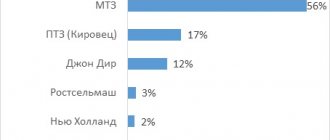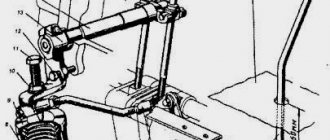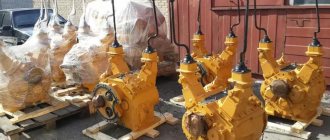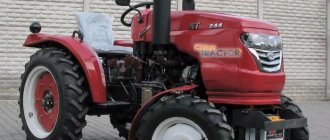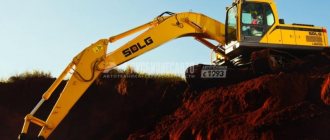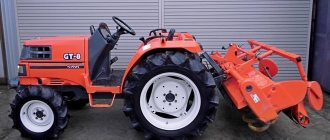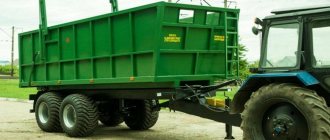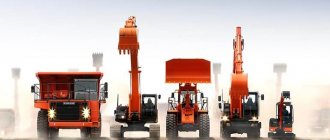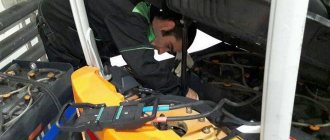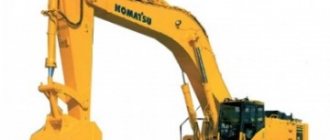Agricultural machinery: types and applications
Agricultural machinery is a large list of industrial means that are designed to increase production labor in agriculture.
This is done due to the fact that individual operations or technological processes are mechanized and automated. Most often, equipment is used for agriculture at an agricultural facility or enterprise. If agricultural machinery is regularly used for agricultural purposes, then its owner, usually an agricultural base, is responsible for its storage and repair. She is also responsible for pets, food procurement and for selling produced products at the market or at a smaller facility.
Different types of special equipment are used for different agricultural work. Depending on the situation, such work requires a special method of care or processing, as well as the necessary specialists.
Types of agricultural machinery
Equipment for cultivating the soil before sowing:
plow – designed to loosen the soil; harrow and roller - crush lumps on the soil and level it.
Equipment for sowing various products:
precision sowing seeder – thanks to it the seeds are placed at the required depth; seedling planting machine – used for seedlings; potato planting machine – used during potato planting;
Irrigation and watering equipment:
- long-range and double-consular rain machine - used to simulate rain. - stationary and ordinary watering and mobile multi-support machine - used for watering. — agricultural machinery for fertilizing the soil with liquid and organic, mineral and solid fertilizers. To fertilize surfaces, simpler techniques are used.
Harvest equipment:
— a combine harvester for harvesting potatoes, corn and other root crops; — combines for harvesting cabbage and onions.
Cleaning equipment includes:
— mowers; — reapers; — grain and forage harvesters; — combines for harvesting potatoes, corn, onions and cabbage.
There is agricultural equipment for almost every crop, which, by the way, contains dozens of DIN 9021 washers. There are various types of equipment for beets, flax, wheat, cotton, grapes and even tea. You can also purchase equipment for making feed, equipment for processing feed, and equipment for caring for livestock.
In addition to all this technology, there are also auxiliary devices and machines. It is very difficult to care for such equipment, so it is necessary to take care of it and select good professionals who will service it.
Categories of self-propelled vehicles and licenses required to operate them
Right to the forklift
Alexey Moshkov, teacher at State Autonomous Educational Institution “Professional”
As a teacher at a training center, I regularly have to deal with facts when students, and what about students - business managers who send specialists to learn how to drive a particular vehicle, have no idea what kind of certificates they need for this. Meanwhile, this issue of ensuring labor safety at the enterprise is extremely important both for workers and for the managers themselves. Indeed, in the event of any incidents at the warehouse, an investigation is carried out, and driving a self-propelled vehicle of one category by a driver who has a tractor driver’s license of another is classified as driving without a license.
In such cases, both direct executors and managers (officials) who allowed the equipment to be controlled by unauthorized personnel are held accountable, and depending on the consequences it can be even criminal. Meanwhile, understanding the categories of self-propelled vehicles and the licenses required to operate them is quite simple. We will be helped in this by Resolution No. 796 of July 12, 1999 of the Government of the Russian Federation “On approval of the Rules for admission to driving self-propelled machines and issuing licenses for tractor driver (tractor operator)”, where the types of machines and the necessary certificates are sorted out.
So, a document that allows driving a self-propelled machine and is handed to the driver is called a tractor driver’s license. It contains entries about the following categories of equipment.
Category A – motor vehicles not intended for driving on public roads or having a maximum design speed of 50 km/h or less. It includes:
• I – off-road motor vehicles (ATVs and snowmobiles fall under this category);
• II – off-road vehicles, the permissible maximum weight of which does not exceed 3.5 thousand kg and the number of seats in which, in addition to the driver’s seat, does not exceed eight (this includes the so-called swamp vehicles - four-wheeled cars with two side-by-side seats side and, as a rule, with a body);
• III – off-road vehicles whose permissible maximum weight exceeds 3.5 thousand kg (except for those belonging to category A IV). An example of a vehicle in this category would be a mining dump truck or an all-terrain vehicle of the Ural-Polyarnik type;
• IV – off-road vehicles designed to transport passengers and having more than eight seats in addition to the driver’s seat (in particular, an apron bus, which is used at airports).
Category B - tracked and wheeled vehicles with an engine power of up to 25.7 kW, no matter what type - be it diesel, petrol or electric. It covers both mini-tractors and mini-excavators, as well as most electric forklifts. The most common special words are “tractor driver” and “electric forklift driver”.
Category C – wheeled vehicles with an engine power from 25.7 to 110.3 kW. This is perhaps the most popular category: it includes both most diesel forklifts and front-end loaders, ranging from their mini version - the Bobcat - to some Amkodor models. The most common special words are “excavator operator” and “tractor driver”. Special marks may be the same as in category C.
Category D – wheeled vehicles with an engine power exceeding 110.3 kW. Powerful front loaders of brands such as Dresta, Volvo, Caterpillar, etc., designed for reloading large-capacity sea containers, are representatives of this category. Special marks may be the same as in category C.
Category E – tracked vehicles with an engine power exceeding 25.7 kW. The most common are the special o and “tractor driver”.
Category F – self-propelled agricultural machines.
The clauses of the resolution determine what entries and marks are allowed to be made on the certificate:
5. In order to ensure control over the compliance of the work performed with the assigned qualifications, a restrictive or permissive entry about the availability of qualifications (qualifications) is made in the special marks column of the tractor driver (tractor operator) certificate.
6. If there is a permit mark (o, “C”, “D” and “E” in the tractor driver’s (tractor driver’s) license, no additional entries are required to perform work that corresponds to the tractor driver’s qualifications.
What are special marks? The fact is that all tractor drivers, like any workers, are trained in educational institutions according to certain programs. There are training programs for tractor drivers, there are for excavator drivers, and there are for loader drivers. There are others, but these are the most common. It is believed that during the training, students acquire the knowledge and skills necessary to safely operate a loader, tractor or excavator. That is, it is not enough for the driver of a loader or stacker to have a license of the appropriate category: in order to be allowed to work, he also needs a corresponding special mark in the certificate. But the absence of special marks is not at all a signal that the “rights” were purchased on the nearest market. Paragraph “6” of the Rules states in which case it may not exist - if the driver has open categories B, C, D and E.
Is it possible not to study for 2.5 months (namely, this is the duration of training to become a tractor driver)? Yes, I have. If you have forklifts with an engine power of up to 4 kW, you do not need a Gostekhnadzor license to drive them. It is enough to have a driver’s license for an electric forklift or stacker with a power of up to 4 kW. Training for this specialty takes less time and costs less. But such a certificate has one drawback: while holders of ordinary tractor driver’s licenses simply change them once every 10 years, then for drivers of loaders with a power of up to 4 kW, annual recertification is provided. It can be completed both at the training center and at the enterprise commission.
Is it necessary to have a separate license to drive a forklift with a power of up to 4 kW if the driver already has a category B license with a special license? No, don't. After all, such a driver’s license says: “wheeled and tracked vehicles with an engine power of up to 25.7 kW.” There is no mention of equipment “from 4 kW” there. How to determine the power of an electric forklift, since it has an electric motor for the movement mechanism, and often more than one, an electric motor for the hydraulic system, which can be even more powerful than electric drive motors, and a separate electric power steering motor? By engine power or total power of the vehicle’s movement engines.
Another point to pay attention to is the driver's rank. In addition to the rights issued by Gostekhnadzor, he must also have a certificate of completion of the courses. It says what rank he is assigned to. Drivers of forklifts of category B have the third, drivers of category C have the fourth category. Categories A, B and C can be studied initially, the remaining categories can be opened after advanced training. The absence of a certificate of completion of the course is a reason to check the authenticity of the tractor driver’s license. In any case, such an employee will have to restore it, since the tractor driver’s license is not changed without it, and the sooner the personnel department inspector discovers such a disorder, the better for the employee himself. Training centers can be liquidated and merged with other organizations. In this case, the archive should be preserved, but searching for the required document may take a lot of time.
So, we have decided on the necessary (but not sufficient) documents to work on a loader or stacker. Let's summarize.
For those who operate equipment with a power of up to 4 kW, a certificate issued by the training center is sufficient. Recertification – once a year.
If an employee operates an electric forklift with a power of more than 4 kW, but not more than 25.7 kW, then he must have a tractor driver’s license with an open category B and a special o. The certificate of completion of training courses requires a record of the assignment of 3rd category.
A candidate for diesel forklift driver must have a category C tractor driver license, 4th category and a special certificate. But only if the loader is no more powerful than 110.3 kW, and speaking in Russian - no more than 150 “horses”.
One more point: all warehouse workers who operate forklifts, electric pallet trucks and stackers (reach trucks) must have valid medical certificates. Those who have a tractor driver's license must have one like that of a car driver, with a note indicating that there are no contraindications for driving self-propelled machines. They must say: “fit to drive tractors and other self-propelled agricultural machines.” It should be explained to the staff that, when passing the driver’s commission, the employee can and must inform the commission about the category of “regular” driver’s license he has. Why go through a commission 10 times if the absence of medical contraindications to driving cars and motorcycles, as well as self-propelled vehicles, can be reflected in one medical certificate?
For workers operating equipment with a power of up to 4 kW, regular certificates issued at any clinic are also suitable. Personnel using forklifts, trolleys and stackers have certificates for the right to operate them and medical certificates - necessary, but far from sufficient conditions for safe work. Therefore, to be continued.
Agricultural machinery and equipment
The development of agriculture, which is an integral part of progress, provides people with many areas of their lives. The modern agro-industrial complex is developing rapidly, showing better results and high efficiency, but this would be impossible to achieve without specialized machinery and equipment, which today performs a lot of complex work.
Highly efficient agricultural machinery and equipment today is a wide range of technical means designed not only to increase productivity, but also to improve technological processes through automation and mechanization of certain operations. In simple words, innovative agricultural equipment and machinery greatly facilitates heavy physical labor, making the work more precise and efficient.
Special equipment in agricultural production
It is impossible to cultivate large areas of land manually. It is equally difficult to eliminate the consequences of this work: remove unusable land, processed part of the land, etc. Therefore, competent farming requires the use of special machines that help cope with economic needs and tasks.
This is true not only for processes and operations related to agriculture, but also for work in the field of raising livestock, birds, and other productive activities.
In all of these areas, it is impossible to do without the use of special equipment. In many ways, the efficiency of the processes being performed depends on it.
Types of agricultural machinery and equipment
Advanced machinery and agricultural technological equipment are divided into several types, where there are different types of agricultural machinery for specific jobs and processes. In particular, modern agricultural technology is divided into three main types:
- Equipment for cultivating and preparing the soil before sowing and directly sowing - this includes machine and tractor units (ploughs, rollers, harrows, planting machines and seeders);
- Machines for caring for crops include hillers, thinners, pruning equipment, as well as machine-tractor units for watering, irrigation and fertilization.
- Harvesting equipment includes combines and other equipment (mowers, row reapers and other types).
Types of agricultural machinery
Farm equipment is very diverse and has its own characteristics.
To work with it, a sufficient level of knowledge and skills in the field of agricultural work is required. Understanding the intricacies and details of each type of machine is a very difficult task. It is customary to classify agricultural machinery according to the type of work performed: livestock farming, farming, land reclamation. The widest range of machines is presented in the field of agricultural work.
Here it is customary to distinguish groups in accordance with certain technological processes:
- daily cultivation of the land;
- sowing, planting;
- caring for growing crops;
- watering, irrigation;
- Harvesting hay using balers
- fertilization;
- harvest;
- post-harvest processing
AtxTop offers a wide selection of new and used machines for agricultural and livestock work.
Here you can also find a large selection of tools for the garden, for example, rotary mowers for walk-behind tractors or for grass, cultivators. In addition, our company is pleased to offer you a wide selection of drip irrigation systems and automatic watering.
Agricultural Equipment Manufacturers
Along with the development of the agricultural sector, Russian manufacturing enterprises are also successfully developing, producing modern agricultural equipment, the demand for which is growing every year. Russia is considered one of the largest players among other countries supplying the market with highly efficient machinery and modern equipment for agriculture.
Russian manufacturers of agricultural equipment include hundreds of factories producing high-tech machines for cultivating soil, caring for crops and harvesting equipment (forage harvesters, tractors and other modern means of mechanization).
Not least important are American, German and Italian manufacturers, who produce truly reliable equipment that pays off all the costs of its purchase. But the largest niche is occupied by Chinese enterprises, which are very popular among agricultural producers.
The basis of production for many Chinese companies is cooperation and production of equipment under license from foreign enterprises and under their full control. The provision of modern production technologies, in turn, ensures the development and production of high-quality agricultural equipment, but at minimal costs. Therefore, Chinese agricultural production occupies far from the last positions in the ratings, offering to the sales market equipment that is inexpensive, in comparison with Russian and other industries, with the same good payback percentage.
Get an advantageous offer from direct suppliers:
Electrical equipment on farms
The main purpose of the devices and units of this group is, of course, to provide farms with electricity. The following types of equipment of this type can be used on farms:
lamps, etc.
Without such devices and units on the farm, it will be impossible to arrange ventilation, provide lighting, and operate milking machines. Without separators you cannot make cream and butter, without refrigerators you cannot store milk, etc.
Agricultural equipment: harvesting equipment
Equipment of this class includes, of course, primarily combines. This technique can be used for harvesting wheat, rye, corn, etc. Almost any modern combine can perform three functions at once: a reaper, a thresher and a winnower.
Also, the group of cleaning equipment may include, for example, such equipment as:
The latter type of equipment is most often used to make hay for farm animals. Row headers, like combines, are used on farms to harvest various types of grain.
Accessories for special equipment
AtxTop offers a wide range of spare parts for various special purpose machines. Here you can find in stock the elements necessary for the repair and maintenance of graders, bulldozers, loaders and excavators. You can also always order the necessary elements, which will be completed as soon as possible.
With the help of our company, you can purchase transmission elements, chassis, engine parts, electronic and air systems for special equipment. In addition, we supply cutting and drilling elements, pumps, filters, booms, handles and special tires.
Our company’s specialists will select the necessary original or analog spare parts that are suitable specifically for your type of equipment. We guarantee the quality of supplied materials for special equipment, as well as compliance with deadlines for their implementation.
AtxTop is a team of professionals in the field of supplying equipment for agricultural and livestock enterprises, as well as parts for it. We value comfort and convenience for our clients. Therefore, we are ready to offer you the most optimal delivery conditions.
Tractors
Such equipment for agriculture is produced by industry in huge quantities. It is this type of equipment that is most in demand on farms and agricultural holdings. Tractors are used very widely in agriculture. Farm assets may include both tracked and wheeled vehicles of this type. The second type of tractor is the most popular on farms. Crawler models on farms are mainly used only in problem areas.
Various types of agricultural work are carried out using such equipment using additional attachments. For agriculture, enterprises can produce, for example, such varieties of similar tools as:
Tractors used in agriculture can be equipped with engines of different power. The cabins of modern cars of this type are usually characterized by a high degree of comfort and are equipped with heaters and air conditioners.
Sprayers
This type of agricultural equipment can be manufactured in the form of mounted tools or trailers. Self-propelled sprayers are also often used on farms and agricultural holdings.
The tank volume of such equipment can vary between 200-2000 liters. Sprayers are used in agriculture to treat fields with herbicides and insecticides. That is, this technique is used mainly to control weeds and pests in plantings. This type of equipment can also be used for spraying liquid fertilizers. Installations of this type are usually attached to wheeled tractors.
Forage machines
This class of agricultural equipment includes, for example:
trailers for transporting bales.
Mowers can also be classified in this category of equipment. Very often, farms also use forage harvesters, among other things. This could be equipment, for example, designed for harvesting beets, potatoes, etc.
This type of equipment can be used for cutting grass, flattening and drying it, forming windrows, pressing rolls and packaging them in a special film. The feed prepared in this way is transported to storage areas on trailers.
Tillage equipment
Such equipment and tools for agriculture are also produced in a very large assortment. The use of modern technology is, of course, necessary not only when planting or harvesting various types of crops, but also when growing them. The class of tillage equipment includes, for example:
screw rollers, etc.
This technique is used to cultivate land in order to improve its qualities. With the help of plows, the soil is made loose and suitable for growing crops. Of course, nothing will grow on unplowed land. Harrows are used to level fields and destroy crust to prevent soil drying out.
Screw rollers in agriculture are used to compact soil in fields. That is, to compact the top layer of soil. This procedure allows you to reduce the loss of planting material and obtain more uniform shoots.
Advantages of purchasing from AtxTop
Our company is engaged not only in the sale of equipment, but also its individual elements and components. With us you can find a wide selection of original or analogue parts for machines, components, assemblies of various types and brands. You can also order components from AtxTop if they are not in stock.
The advantages of working with us are the quality of services provided and prompt delivery. In addition, our company’s specialists will help you select the necessary spare parts for agricultural machinery and advise you on all questions of interest.
Types of agricultural machinery
Harvesting equipment
In the modern agro-industrial complex, in order to achieve the highest yields of various types of crops (wheat, corn, etc.), it is necessary to use special agricultural machinery. The leading position here is occupied by the grain harvester.
The combine performs its functions better than other equipment designed for these operations. A special feature of this equipment is the ability to perform such functions as a reaper, winnower and thresher.
In a word, a grain harvester allows you to get already cleaned grain from a wide variety of agricultural crops.
When choosing such a machine, in addition to its power, you should also pay attention to the type of threshing apparatus, separation system and grain bin volume.
Modern combine harvesters have three types of threshing apparatus: axial rotary, pin and hammer. They all differ in the volume of grain that goes along with the straw. The first type has the best performance.
Tractors
Depending on its purpose, this type of agricultural machinery can be equipped with tracks or wheels. A tractor is used when it is necessary to apply traction force to perform a specific task.
Also, these machines can be classified into the following types: for forestry, gardening, viticulture, mini-tractors, etc.
Such agricultural machinery does not have great speed, but it is not needed. Power traction is needed here, and crawler tractors are the leader here. They are ideal for working on loose soil. Any other equipment here will simply load and get stuck.
Wheeled tractors are used to solve problems in areas where there is a hard surface road.
Characteristics that a tractor must have:
- Power;
- Quick change of attachments. This allows you to switch between different types of work in a short time;
- Easy to maintain even in the field;
- Ability to connect various equipment used in agricultural work.
Sprayers
In order to produce fertilizer in a timely and high-quality manner, which allows you to protect the plant and stimulate its effective growth, a special type of equipment is currently used - sprayers. They can be designed as attachments, trailers, or self-propelled.
The choice of spraying equipment depends on the area of available fields. For small agriculture, attachments are quite enough. Self-propelled sprayers are much more expensive, but they can quickly cover large areas of crops.
Sowing technology
Sowing technology can achieve the most effective results. Such equipment includes seeders, storage tanks, and bunkers. They are intended for prompt and, most importantly, effective sowing of grain or seeds. With their help, it is possible to sow various grain crops as densely as possible.
Also, sowing technology minimizes the amount of crushed grain. Today, such equipment occupies a special place in providing the agro-industrial complex.
Tillage machines
In the process of growing various crops, various activities are carried out. This also includes preparing the land for planting. Obtaining the most effective result depends on its correct implementation. To help with this, special tillage equipment is used.
Depending on the type of soil, such units are capable of performing a variety of types of work: deep plowing, surface cultivation, soil compaction, loosening, etc. Without this equipment, it is very difficult to imagine these works on a large scale.
Forage machines
Today, the preparation of feed for cattle and other animals is carried out using this technology. These can be tedders, windrowers, mowers, and balers.
With the help of such machines it is possible to achieve maximum efficiency when performing these types of work. These are reliable units that can be operated in the most difficult conditions, simple and comfortable to operate.
Types of special machines in agriculture
It is customary to classify equipment according to the type of work performed or the profile of the tasks performed.
In the first case, special types of equipment include:
- loaders, mini loaders;
- excavators, bulldozers;
- attachments.
The functionality of these machines boils down to lifting a load of large volume and weight and transporting it to another part of the farmland, digging a hole or pit if necessary, as well as many other tasks. All of them are extremely important elements of agricultural and livestock activities. Without performing such operations, production can have significant losses in time and, as a result, in yield.
It is also customary to distinguish between special equipment for cultivating individual crops. Special agricultural machinery can be designed for:
- sugar beets;
- grapes, hops;
- tea;
- flax;
- cotton;
- forests.
For example, a tea trimming machine or a flax thresher can be classified as narrow-profile.
